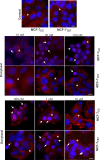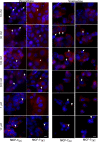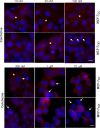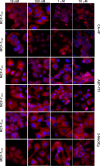Sensitivity of docetaxel-resistant MCF-7 breast cancer cells to microtubule-destabilizing agents including vinca alkaloids and colchicine-site binding agents
- PMID: 28787019
- PMCID: PMC5546696
- DOI: 10.1371/journal.pone.0182400
Sensitivity of docetaxel-resistant MCF-7 breast cancer cells to microtubule-destabilizing agents including vinca alkaloids and colchicine-site binding agents
Abstract
Introduction: One of the main reasons for disease recurrence in the curative breast cancer treatment setting is the development of drug resistance. Microtubule targeted agents (MTAs) are among the most commonly used drugs for the treatment of breaset cancer and therefore overcoming taxane resistance is of primary clinical importance. Our group has previously demonstrated that the microtubule dynamics of docetaxel-resistant MCF-7TXT cells are insensitivity to docetaxel due to the distinct expression profiles of β-tubulin isotypes in addition to the high expression of p-glycoprotein (ABCB1). In the present investigation we examined whether taxane-resistant breast cancer cells are more sensitive to microtubule destabilizing agents including vinca alkaloids and colchicine-site binding agents (CSBAs) than the non-resistant cells.
Methods: Two isogenic MCF-7 breast cancer cell lines were selected for resistance to docetaxel (MCF-7TXT) and the wild type parental cell line (MCF-7CC) to examine if taxane-resistant breast cancer cells are sensitive to microtubule-destabilizing agents including vinca alkaloids and CSBAs. Cytotoxicity assays, immunoblotting, indirect immunofluorescence and live imaging were used to study drug resistance, apoptosis, mitotic arrest, microtubule formation, and microtubule dynamics.
Results: MCF-7TXT cells were demonstrated to be cross resistant to vinca alkaloids, but were more sensitive to treatment with colchicine compared to parental non-resistant MCF-7CC cells. Cytotoxicity assays indicated that the IC50 of MCF-7TXT cell to vinorelbine and vinblastine was more than 6 and 3 times higher, respectively, than that of MCF-7CC cells. By contrast, the IC50 of MCF-7TXT cell for colchincine was 4 times lower than that of MCF-7CC cells. Indirect immunofluorescence showed that all MTAs induced the disorganization of microtubules and the chromatin morphology and interestingly each with a unique pattern. In terms of microtubule and chromain morphology, MCF-7TXT cells were more resistant to vinorelbine and vinblastine, but more sensitive to colchicine compared to MCF-7CC cells. PARP cleavage assay further demonstrated that all of the MTAs induced apoptosis of the MCF-7 cells. However, again, MCF-7TXT cells were more resistant to vinorelbine and vinblastine, and more sensitive to colchicine compared to MCF-7CC cells. Live imaging demonstrated that the microtubule dynamics of MCF-7TXT cells were less sensitive to vinca alkaloids, and more sensitive to colchicine. MCF-7TXT cells were also noted to be more sensitive to other CSBAs including 2MeOE2, ABT-751 and phosphorylated combretastatin A-4 (CA-4P).
Conclusion: Docetaxel-resistant MCF-7TXT cells have demonstrated cross-resistance to vinca alkaloids, but appear to be more sensitive to CSBAs (colchicine, 2MeOE2, ABT-751 and CA-4P) compared to non-resistant MCF-7CC cells. Taken together these results suggest that CSBAs should be evaluated further in the treatment of taxane resistant breast cancer.
Conflict of interest statement
Figures









Similar articles
-
Multiple mechanisms underlying acquired resistance to taxanes in selected docetaxel-resistant MCF-7 breast cancer cells.BMC Cancer. 2014 Jan 22;14:37. doi: 10.1186/1471-2407-14-37. BMC Cancer. 2014. PMID: 24447372 Free PMC article.
-
Live Imaging to Study Microtubule Dynamic Instability in Taxane-resistant Breast Cancers.J Vis Exp. 2017 Feb 20;(120):55027. doi: 10.3791/55027. J Vis Exp. 2017. PMID: 28287508 Free PMC article.
-
Enhanced stability of microtubules contributes in the development of colchicine resistance in MCF-7 cells.Biochem Pharmacol. 2017 May 15;132:38-47. doi: 10.1016/j.bcp.2017.02.018. Epub 2017 Feb 27. Biochem Pharmacol. 2017. PMID: 28242250
-
Microtubule-binding natural products for cancer therapy.Planta Med. 2010 Aug;76(11):1037-43. doi: 10.1055/s-0030-1250073. Epub 2010 Jun 24. Planta Med. 2010. PMID: 20577942 Review.
-
New insights into Vinca alkaloids resistance mechanism and circumvention in lung cancer.Biomed Pharmacother. 2017 Dec;96:659-666. doi: 10.1016/j.biopha.2017.10.041. Epub 2017 Nov 6. Biomed Pharmacother. 2017. PMID: 29035832 Review.
Cited by
-
Anti-apoptotic effects of autophagy via ROS regulation in microtubule-targeted and PDGF-stimulated vascular smooth muscle cells.Korean J Physiol Pharmacol. 2018 May;22(3):349-360. doi: 10.4196/kjpp.2018.22.3.349. Epub 2018 Apr 25. Korean J Physiol Pharmacol. 2018. PMID: 29719457 Free PMC article.
-
Targeting CDK1 and copper homeostasis in breast cancer via a nanopolymer drug delivery system.Cell Biol Toxicol. 2024 Dec 26;41(1):16. doi: 10.1007/s10565-024-09958-2. Cell Biol Toxicol. 2024. PMID: 39724454 Free PMC article.
-
Mechanistic evaluation of phytochemicals in breast cancer remedy: current understanding and future perspectives.RSC Adv. 2018 Aug 22;8(52):29714-29744. doi: 10.1039/c8ra04879g. eCollection 2018 Aug 20. RSC Adv. 2018. PMID: 35547279 Free PMC article. Review.
-
Repurposing screen identifies mebendazole as a clinical candidate to synergise with docetaxel for prostate cancer treatment.Br J Cancer. 2020 Feb;122(4):517-527. doi: 10.1038/s41416-019-0681-5. Epub 2019 Dec 17. Br J Cancer. 2020. PMID: 31844184 Free PMC article.
-
Cryo-EM structures reveal distinct mechanisms of inhibition of the human multidrug transporter ABCB1.Proc Natl Acad Sci U S A. 2020 Oct 20;117(42):26245-26253. doi: 10.1073/pnas.2010264117. Epub 2020 Oct 5. Proc Natl Acad Sci U S A. 2020. PMID: 33020312 Free PMC article.
References
-
- Lal S, Mahajan A, Chen WN, Chowbay B. Pharmacogenetics of target genes across doxorubicin disposition pathway: a review. CurrDrug Metab. 2010;11(1):115–28. - PubMed
-
- Jemal A, Bray F, Center MM, Ferlay J, Ward E, Forman D. Global cancer statistics. CA Cancer JClin. 2011;61(2):69–90. - PubMed
-
- Murray S, Briasoulis E, Linardou H, Bafaloukos D, Papadimitriou C. Taxane resistance in breast cancer: mechanisms, predictive biomarkers and circumvention strategies. Cancer TreatRev. 2012;38(7):890–903. - PubMed
-
- Kamangar F, Dores GM, Anderson WF. Patterns of cancer incidence, mortality, and prevalence across five continents: defining priorities to reduce cancer disparities in different geographic regions of the world. Journal of clinical oncology: official journal of the American Society of Clinical Oncology. 2006;24(14):2137–50. Epub 2006/05/10. doi: 10.1200/jco.2005.05.2308. . - DOI - PubMed
-
- Yardley DA. Drug resistance and the role of combination chemotherapy in improving patient outcomes. Int J Breast Cancer. 2013;2013:137414 Epub 2013/07/19. doi: 10.1155/2013/137414. ; PubMed Central PMCID: PMCPmc3707274. - DOI - PMC - PubMed
MeSH terms
Substances
LinkOut - more resources
Full Text Sources
Other Literature Sources
Medical

